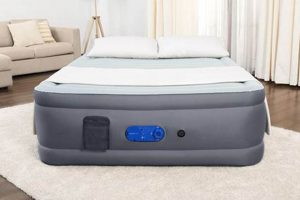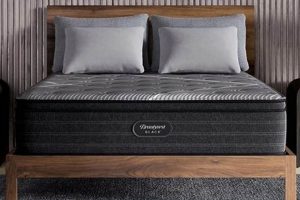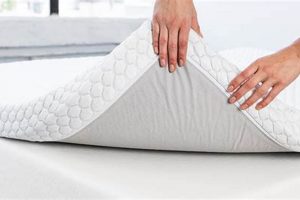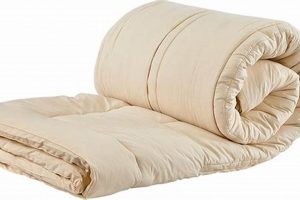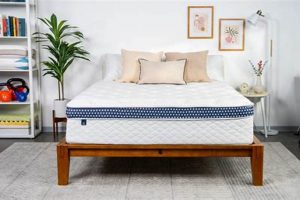A sleeping surface specifically designed to fit a child’s twin-sized bed frame and provide optimal comfort and support is a crucial element in fostering healthy sleep habits. Such a product aims to accommodate the unique physiological needs of growing children, offering a balance of pressure relief and spinal alignment necessary for restful sleep.
The selection of an appropriate sleeping surface significantly contributes to a child’s overall well-being. Adequate sleep supports cognitive development, physical growth, and emotional regulation. Historically, the availability of specialized mattresses for children has increased alongside growing awareness of the importance of sleep health in pediatric development. This increased awareness has driven demand for options specifically tailored to meet the needs of younger sleepers.
Factors influencing the suitability of a child’s sleeping surface include material composition, firmness level, construction, and safety certifications. Subsequent sections will delve into these critical considerations to provide a comprehensive understanding of the criteria involved in selecting the most appropriate sleeping solution for a child’s twin bed.
Guidance for Selecting an Optimal Sleeping Surface
Selecting an appropriate mattress for a child’s twin bed requires careful consideration of several factors to ensure adequate comfort, support, and safety. The following guidelines provide essential insights for making an informed decision.
Tip 1: Prioritize Material Safety. Look for certifications such as CertiPUR-US or GREENGUARD Gold. These certifications indicate that the mattress has been tested for harmful chemicals and volatile organic compounds (VOCs), minimizing potential health risks for the child.
Tip 2: Consider Foam Density. Higher density foam provides greater support and durability, crucial for growing children. Low-density foams may break down quickly, leading to discomfort and inadequate spinal alignment.
Tip 3: Evaluate Firmness Level. A medium-firm mattress is generally recommended for children. This firmness level offers a balance of comfort and support, promoting healthy spinal development without being excessively rigid.
Tip 4: Assess Edge Support. Strong edge support prevents the child from rolling off the bed and extends the usable sleeping surface. This is particularly important for children who tend to move around during sleep.
Tip 5: Examine Construction Type. Options include innerspring, memory foam, latex, and hybrid mattresses. Each type offers distinct characteristics in terms of support, pressure relief, and temperature regulation. Research each option to determine the most suitable choice for the child’s specific needs and preferences.
Tip 6: Consider Hypoallergenic Properties. Children with allergies or sensitivities may benefit from mattresses constructed with hypoallergenic materials. These materials resist dust mites, mold, and other common allergens, promoting a healthier sleep environment.
Tip 7: Factor in Breathability. Mattresses with enhanced breathability help regulate temperature, preventing overheating and promoting comfortable sleep, particularly important in warmer climates or for children who tend to sleep hot.
Selecting a mattress that meets the specific needs of a child’s developmental stage and physical characteristics contributes significantly to sleep quality and overall well-being.
The subsequent sections will explore common mattress types and their suitability for children.
1. Firmness and Support
The relationship between firmness and support is paramount when selecting a sleeping surface for children. Inadequate firmness can lead to improper spinal alignment, potentially hindering musculoskeletal development. Excessive softness may result in the child sinking too deeply into the mattress, disrupting airflow and creating an uncomfortable sleep environment. Conversely, a surface that is too firm can exert undue pressure on bony prominences, leading to discomfort and restlessness. Selecting a product with appropriate firmness and support levels directly influences a child’s sleep quality and overall physical health.
Illustrative examples demonstrate the practical implications of this connection. A mattress lacking sufficient support can contribute to back pain and poor posture in children. A memory foam mattress with low-density foam may initially feel comfortable but quickly lose its supportive properties, leading to spinal misalignment over time. The practical significance of understanding firmness and support lies in preventing these adverse effects. Parents and caregivers should prioritize mattresses designed to provide balanced support, ensuring the child’s spine remains properly aligned throughout the night. Reputable manufacturers often specify firmness levels and weight recommendations, offering guidance for appropriate selection.
The integration of firmness and support is a crucial element in determining the overall suitability of a mattress for a child’s twin bed. Achieving the correct balance minimizes the risk of physical discomfort, promotes healthy spinal development, and facilitates restful sleep. Challenges in this area often stem from the diverse range of available products and varying marketing claims. It is vital to conduct thorough research, consider reputable certifications, and, when possible, allow the child to test the mattress before making a purchase. The ultimate goal is to provide a sleeping surface that promotes optimal well-being and supports healthy growth patterns.
2. Material Safety
The construction of a mattress for a child necessitates stringent adherence to material safety standards. The correlation between the composition of a mattress and potential health risks is direct; therefore, careful material selection is paramount. Components containing volatile organic compounds (VOCs), phthalates, or flame retardants can release airborne toxins, potentially causing respiratory irritation, allergic reactions, or endocrine disruption in children. The inclusion of materials with verified safety certifications is a critical component of any product designated as the optimal choice for a childs sleeping environment.
Certifications, such as CertiPUR-US or GREENGUARD Gold, serve as independent validation of a mattress’s chemical composition. These certifications signify that the mattress has undergone rigorous testing to ensure it meets established safety standards for emissions and harmful substances. For instance, a mattress lacking CertiPUR-US certification may contain polyurethane foam manufactured with potentially harmful chemicals. The practical implication of understanding this connection is that prioritizing certified products significantly reduces the risk of exposing children to hazardous substances during sleep, a per
iod of heightened vulnerability.
Ultimately, ensuring material safety is not merely a desirable attribute but a fundamental requirement for any mattress intended for use by children. Challenges arise when deceptive marketing practices obscure the true composition of a product. By focusing on verifiable certifications and reputable manufacturers, parents and caregivers can mitigate these risks and provide a sleeping surface that supports a child’s health and well-being. The selection of a chemically safe mattress directly contributes to a healthier indoor environment and fosters optimal developmental conditions for children.
3. Size and Fit
The congruence between mattress dimensions and bed frame specifications is a foundational element in ensuring both safety and functionality. When selecting a sleeping surface, precise measurements and adherence to standardized sizes are critical. Discrepancies in these dimensions can compromise the structural integrity of the bed and pose safety hazards for the child.
- Standard Twin Dimensions
A standard twin mattress typically measures approximately 38 inches in width and 75 inches in length. Deviations from these dimensions can lead to either excessive movement within the frame or difficulty in installation. Accurate measurements of both the mattress and the bed frame are necessary to prevent potential instability or safety concerns. For example, a mattress that is too small may create gaps between the mattress and the frame, posing a risk of entrapment.
- Frame Compatibility
The internal dimensions of the twin bed frame must precisely accommodate the mattress to prevent shifting or slippage during use. Gaps between the mattress and the frame can not only compromise support but also create potential hazards for children who may become wedged in the open space. Ensuring that the mattress fits snugly within the frame is essential for safety and optimal sleep surface performance.
- Height Considerations
Mattress height, although often overlooked, can significantly impact the overall safety and accessibility of the bed. An excessively tall mattress, when combined with a bed frame, may create a climbing hazard or make it difficult for younger children to get in and out of bed independently. Conversely, a mattress that is too low may make it difficult for adults to assist the child or change bedding comfortably. Careful consideration of mattress height in relation to the bed frame is essential for ensuring accessibility and preventing potential injuries.
- Weight Capacity Implications
Oversized or excessively heavy mattresses can exceed the weight capacity of certain twin bed frames, particularly those constructed from lighter materials. Exceeding the weight limit can compromise the frame’s structural integrity, potentially leading to collapse or damage. Manufacturers typically specify weight limits for both mattresses and bed frames, and these specifications should be carefully reviewed prior to purchase to ensure compatibility and prevent structural failure.
The correlation between precise sizing, frame compatibility, height considerations, and weight capacity directly influences the safety, usability, and longevity of the sleeping arrangement. Selecting a twin mattress that adheres to standard dimensions and aligns with the specifications of the bed frame is a critical step in providing a secure and supportive sleep environment for children.
4. Durability
The longevity and sustained performance of a mattress are critical factors, particularly in the context of children’s bedding. A durable product withstands consistent use, resists degradation, and maintains its supportive properties over an extended period. The investment in a robust mattress translates to long-term cost savings and ensures a consistent and healthy sleep environment.
- Material Resilience
The inherent properties of the materials used in construction dictate a mattress’s capacity to resist wear and tear. High-density foams, reinforced innerspring systems, and tightly woven fabrics contribute to the overall resilience of the product. For example, a low-density memory foam mattress is likely to degrade more rapidly under the weight and movement of a child compared to a high-density latex alternative. The resilience of the materials directly impacts the lifespan and sustained comfort of the sleeping surface.
- Construction Integrity
The method of assembly and the quality of stitching and bonding agents determine the structural integrity of the mattress. Reinforced seams and secure bonding prevent premature separation of layers, preventing sagging and uneven support. Mattresses with weak or poorly executed construction are more prone to developing indentations and losing their shape, negatively affecting spinal alignment and sleep quality.
- Resistance to Compression
A durable mattress exhibits minimal compression over time, maintaining its original thickness and support. Persistent compression leads to reduced cushioning and increased pressure points, potentially causing discomfort and disrupting sleep. Materials with high resistance to compression, such as coil systems or high-density foams, are essential for preserving the mattress’s ability to provide consistent support throughout its lifespan.
- Warranty Provisions
The length and scope of the manufacturer’s warranty often serve as an indicator of the confidence they have in the product’s durability. A comprehensive warranty protects against defects in materials and workmanship, providing assurance that the mattress will maintain its performance characteristics for a specified period. It is crucial to review the warranty terms carefully to understand the extent of coverage and any limitations that may apply.
The facets of material resilience, construction integrity, resistance to compression, and warranty provisions collectively determine the long-term durability and value of a mattress. These factors are particularly relevant for children’s mattresses, which are subject to considerable use and require sustained support for healthy development. The selection of a durable option ensures that the sleeping surface remains a consistent and supportive element of a child’s sleep environment for years to come.
5. Temperature Regulation
Optimal temperature regulation is crucial in the selection of a sleeping surface for children. The ability of a mattress to effectively dissipate heat and maintain a comfortable thermal environment directly impacts sleep quality and overall well-being. A mattress that fails to regulate temperature can lead to overheating, restlessness, and disrupted sleep cycles.
- Material Breathability
The breathability of mattress materials significantly influences temperature regulation. Open-cell foams, natural fibers like cotton and wool, and ventilated designs promote airflow, allowing heat and moisture to dissipate away from the body. Conversely, dense, non-breathable materials can trap heat, creating an uncomfortable microcli
mate. The practical effect of material breathability is a reduction in nighttime sweating and improved sleep continuity. - Construction Techniques
Mattress construction techniques also play a pivotal role in temperature management. Hybrid mattresses, which combine innerspring systems with layers of foam, often exhibit enhanced airflow due to the open structure of the coil system. Similarly, mattresses with channeled foam or perforated layers promote ventilation, facilitating heat transfer. The integration of these construction techniques mitigates the risk of overheating, fostering a more restful sleep environment.
- Cooling Technologies
Advanced cooling technologies, such as gel-infused foams and phase-change materials, are increasingly incorporated into mattresses to enhance temperature regulation. Gel-infused foams dissipate heat more effectively than traditional memory foam, while phase-change materials absorb and release heat to maintain a consistent temperature. The adoption of these technologies can provide a proactive approach to managing heat, particularly for children who tend to sleep hot.
- Cover Fabrics
The fabric used for the mattress cover directly influences its ability to regulate temperature. Breathable fabrics like Tencel or bamboo allow for efficient moisture wicking, promoting evaporation and preventing the buildup of humidity. In contrast, synthetic fabrics can restrict airflow and trap heat. The selection of a breathable cover fabric complements other temperature-regulating features, contributing to a more comfortable sleep experience.
The collective impact of material breathability, construction techniques, advanced cooling technologies, and cover fabrics determines the overall temperature-regulating capacity of a mattress. When choosing a product, these factors should be carefully considered to ensure a comfortable and undisturbed sleep environment, particularly given children’s sensitivity to temperature fluctuations. A mattress that effectively regulates temperature promotes deeper, more restorative sleep, contributing positively to physical and cognitive development.
Frequently Asked Questions Regarding Sleeping Surfaces for Children’s Twin Beds
The following addresses common inquiries concerning the selection and maintenance of optimal sleeping surfaces designed for use in children’s twin beds. These responses are intended to provide clear, informative guidance based on established best practices.
Question 1: What is the recommended firmness level for a mattress intended for a child’s twin bed?
A medium-firm mattress is generally advised. This firmness level provides a balance of support and comfort, promoting proper spinal alignment without being excessively rigid or allowing excessive sinking. However, individual preferences and any specific recommendations from a pediatrician or healthcare professional should also be considered.
Question 2: How frequently should a child’s mattress be replaced?
A mattress should be replaced when it exhibits signs of wear and tear, such as sagging, indentations, or loss of support. Generally, a high-quality mattress can last between 7 to 10 years. However, factors such as the child’s growth, weight, and any changes in their physical needs may necessitate earlier replacement.
Question 3: What safety certifications should be considered when purchasing a mattress?
Certifications such as CertiPUR-US and GREENGUARD Gold are essential. These certifications indicate that the mattress has been tested for harmful chemicals, VOC emissions, and other potentially hazardous substances, minimizing the risk of exposure to toxins.
Question 4: How can the lifespan of a mattress be prolonged?
Utilizing a mattress protector is highly recommended to safeguard against spills, stains, and dust mites. Regularly rotating the mattress, typically every 3 to 6 months, can help distribute wear evenly. Adhering to the manufacturer’s cleaning and maintenance guidelines is also crucial.
Question 5: Are innerspring or foam mattresses better suited for children?
Both innerspring and foam mattresses can be appropriate, depending on individual needs and preferences. Innerspring mattresses provide good support and airflow, while foam mattresses offer enhanced pressure relief and motion isolation. Hybrid mattresses, combining both innerspring and foam layers, can provide a balance of these benefits.
Question 6: What steps should be taken to address concerns regarding off-gassing from a new mattress?
Allowing the new mattress to air out in a well-ventilated room for several days prior to use can help mitigate any potential off-gassing odors. Selecting mattresses with low VOC emissions and certifications such as GREENGUARD Gold can also minimize this concern. If persistent odors or sensitivities occur, consulting with the manufacturer or a healthcare professional is advisable.
The information presented aims to address frequently encountered queries surrounding the selection, maintenance, and safety considerations associated with sleeping surfaces. Understanding these key points aids in making informed decisions and ensuring the provision of a safe, supportive, and comfortable sleeping environment for children.
Subsequent sections will delve into specific mattress types and their suitability for various needs and preferences.
Optimal Sleeping Surfaces for Children
The selection of the most appropriate product necessitates a comprehensive understanding of various critical factors. Firmness, material safety, dimensions, durability, and temperature regulation have all been identified as essential elements in promoting healthy sleep habits and supporting the physical development of children. Careful evaluation of these attributes is imperative in ensuring the chosen sleeping surface meets the specific needs of the child.
Prioritizing a safe and supportive sleeping environment directly contributes to a child’s overall well-being. Continued advancements in mattress technology and increased awareness of pediatric sleep health will likely lead to even more refined and specialized sleeping solutions in the future. Ongoing vigilance and informed decision-making remain crucial in fostering optimal sleep conditions for growing children.


